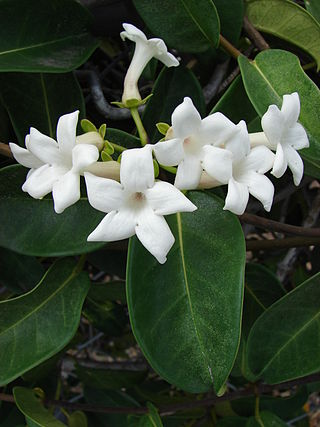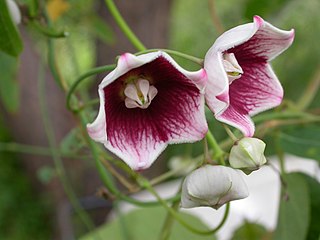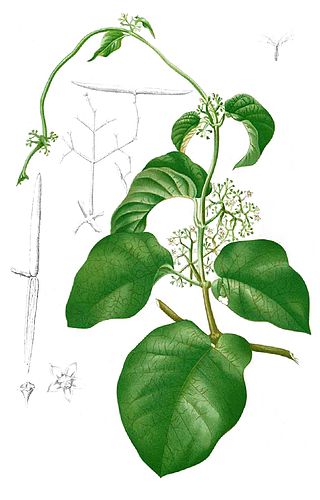
The Asclepiadoideae are a subfamily of plants in the family Apocynaceae. Formerly, they were treated as a separate family under the name Asclepiadaceae, e.g. by APG II, and known as the milkweed family.

Cynanchum is a genus of about 300 species including some swallowworts, belonging to the family Apocynaceae. The taxon name comes from Greek kynos and anchein, hence the common name for several species is dog-strangling vine. Most species are non-succulent climbers or twiners. There is some evidence of toxicity.

Duvalia is a succulent plant genus in the subfamily Asclepiadoideae, in the family Apocynaceae (dogbane).

Vincetoxicum rossicum is a flowering plant in the family Apocynaceae. It is a perennial herb native to southern Europe and is a highly invasive plant growing in all of the Eastern United States, in the mid west, and southern Ontario and Quebec in Canada. It has several common names including swallowwort, pale swallowwort, and dog-strangling vine; though it does not actually strangle dogs, it can “strangle” native plants and small trees if it is in dense patches. There has historically been much confusion about the genus it belongs to, with authors placing it within Vincetoxicum and others within Cynanchum, but recent molecular and chemical analyses have shown it to belong in the genus Vincetoxicum.

Marsdenia is a genus of plants in the family Apocynaceae first described as a genus in 1810. It is named in honor of the plant collector and Secretary of the Admiralty, William Marsden. The plants are native to tropical regions in Asia, Africa, Australia, and the Americas.

Vincetoxicum is a genus of plants in the family Apocynaceae. Although the species in Vincetoxicum have sometimes been included in Cynanchum, chemical and molecular evidence shows that Vincetoxicum is more closely related to Tylophora, now included in Vincetoxicum. The generic name means "poison-beater" in Botanical Latin because of the plants' supposed antidotal effects against snakebite.

Cynanchum viminale is a leafless succulent plant in the family Apocynaceae. The species is native to West Africa, the Indian Ocean and Western Pacific region. The species' natural range extends from South Africa throughout much of Africa and the Middle East to India, Indochina, Southern China, Indomalaya and into Meganesia. The species is also found on several Indian Oceans islands including Mauritius, Réunion and the Seychelles.

Periplocoideae is a subfamily of the dogbane plant family, Apocynaceae. It was not divided into tribes as of 2014.
Aspidoglossum is a genus of plants in the family Apocynaceae, first described as a genus in 1838. It is native to Africa.

Piaranthus is a succulent plant genus in the subfamily Asclepiadoideae, in the family Apocynaceae.

Heterostemma is a genus of plants in the family Apocynaceae, first described in 1834. It is native to India, China, Taiwan, Southeast Asia, Australia, and certain islands in the Pacific.

Pachycarpus is a genus of plants in the family Apocynaceae, first described in 1838. It is native to Africa.
Vincetoxicum oblongum is a species of plants in the family Apocynaceae, native from west tropical Africa to south-west Ethiopia. Its synonyms include Oncostemma cuspidatum, at one time placed as the only species in the genus Oncostemma.

Orthanthera is a genus of plants in the family Apocynaceae, first described as a genus in 1834. It is native to India and Africa.
- Orthanthera albidaSchinz - Namibia
- Orthanthera butayei(De Wild.) Werderm. - Zaire
- Orthanthera gossweileriC.Norman - Angola
- Orthanthera jasminiflora(Decne.) N.E.Br. ex Schinz - South Africa
- Orthanthera strictaHiern - Angola
- Orthanthera vimineaWight - Uttar Pradesh in India

Oxystelma is a genus of flowering plants of the family Apocynaceae, first described as a genus in 1810. It is native to Africa and Asia.

Streptocaulon is a genus of plants in the family Apocynaceae, first described as a genus in 1834. It is native to India, China and Southeast Asia.
Vincetoxicum lineare is a species of plant in the family Apocynaceae native to Australia. Known as the bush bean, it is an edible species of plant found in arid regions. As Rhyncharrhena linearis, the species was at one time the only species in the monotypic genus Rhyncharrhena.

Vincetoxicum bracteatum, synonyms including Tylophora pauciflora, is a species of climbing plant in the family Apocynaceae. It is commonly known as kiri aguna in Sri Lanka. It is edible and is used in traditional medicine. It was first described by Carl Peter Thunberg in 1821 as Cynanchum bracteatum.














